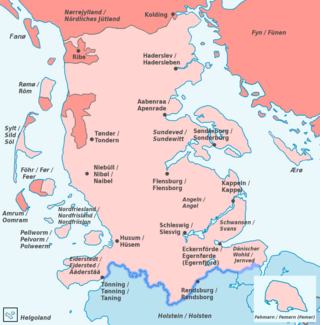
The Duchy of Schleswig was a duchy in Southern Jutland covering the area between about 60 km north and 70 km (45 mi) south of the current border between Germany and Denmark. The territory has been divided between the two countries since 1920, with Northern Schleswig in Denmark and Southern Schleswig in Germany. The region is also called Sleswick in English.

Duke is a male title either of a monarch ruling over a duchy, or of a member of royalty, or nobility. As rulers, dukes are ranked below emperors, kings, grand princes, grand dukes, and sovereign princes. As royalty or nobility, they are ranked below princes and grand dukes. The title comes from French duc, itself from the Latin dux, 'leader', a term used in republican Rome to refer to a military commander without an official rank, and later coming to mean the leading military commander of a province. In most countries, the word duchess is the female equivalent.

Count is a historical title of nobility in certain European countries, varying in relative status, generally of middling rank in the hierarchy of nobility. Especially in earlier medieval periods the term often implied not only a certain status, but also that the count had specific responsibilities or offices. The etymologically related English term "county" denoted the territories associated with some countships, but not all.
Margrave was originally the medieval title for the military commander assigned to maintain the defence of one of the border provinces of the Holy Roman Empire or a kingdom. That position became hereditary in certain feudal families in the Empire and the title came to be borne by rulers of some Imperial principalities until the abolition of the Empire in 1806. Thereafter, those domains were absorbed into larger realms or the titleholders adopted titles indicative of full sovereignty.

The history of Schleswig-Holstein consists of the corpus of facts since the pre-history times until the modern establishing of the Schleswig-Holstein state.

The Swedish nobility has historically been a legally and/or socially privileged class in Sweden, and part of the so-called frälse. The archaic term for nobility, frälse, also included the clergy, a classification defined by tax exemptions and representation in the diet. Today the nobility does not maintain its former legal privileges although family names, titles and coats of arms are still protected. The Swedish nobility consists of both "introduced" and "unintroduced" nobility, where the latter has not been formally "introduced" at the House of Nobility (Riddarhuset). The House of Nobility still maintains a fee for male members over the age of 18 for upkeep on pertinent buildings in Stockholm.
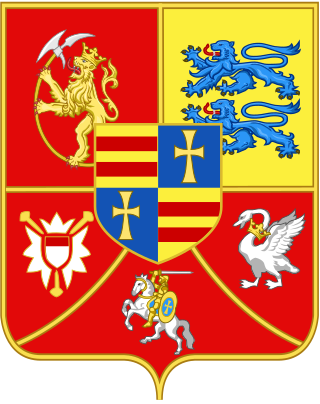
Holstein-Gottorp or Schleswig-Holstein-Gottorp is the historiographical name, as well as contemporary shorthand name, for the parts of the duchies of Schleswig and Holstein, also known as Ducal Holstein, that were ruled by the dukes of Schleswig-Holstein-Gottorp, a side branch of the elder Danish line of the German House of Oldenburg. Other parts of the duchies were ruled by the kings of Denmark.
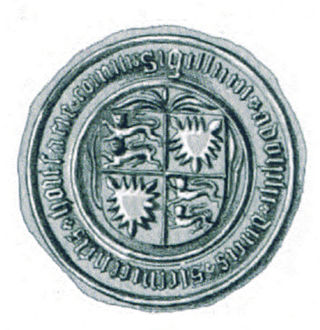
Adolphus XI of Schauenburg, as Adolph I Duke of Schleswig, and as Adolph VIII Count of Holstein-Rendsburg, was the mightiest vassal of the Danish realm.
The aristocracy of Norway is the modern and medieval aristocracy in Norway. Additionally, there have been economical, political, and military elites that—relating to the main lines of Norway's history—are generally accepted as nominal predecessors of the aforementioned. Since the 16th century, modern aristocracy is known as nobility.
A substantive title is a title of nobility or royalty acquired either by individual grant or by inheritance. It is to be distinguished from a title shared among cadets, borne as a courtesy title by a peer's relatives, or acquired through marriage.

The Reventlow family is a Holstein and Mecklenburg Dano-German noble family, which belongs to the Equites Originarii Schleswig-Holstein. Alternate spellings include Revetlo, Reventlo, Reventlau, Reventlou, Reventlow, Refendtlof and Reffentloff.

The Baudissin family is a German noble family of Sorbian origin, first mentioned in 1326 in Upper Lusatia, now part of Saxony. At the time Bautzen, the district capital, was called Budissin, whence the name originated. All name bearers, including those of family lines like Baudissin-Zinzendorf and Baudissin-Zinzendorf-Pottendorf, are Counts or Countesses.
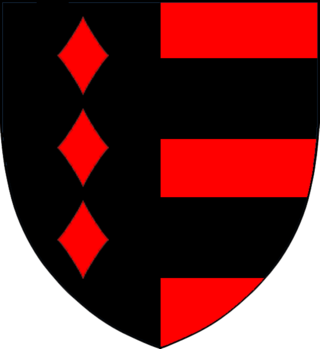
The Thienen family is the name of an ancient noble family, that origins in the Duchy of Holstein. The spelling of the name, over the centuries has changed from Tyne and Tynen to Thien, Tienen, Thinen and finally Thienen. The barons of Thienen-Adlerflycht are the only branch of this family still existing; they belong to the high nobility of Denmark.

The Duchy of Holstein was the northernmost state of the Holy Roman Empire, located in the present German state of Schleswig-Holstein. It originated when King Christian I of Denmark had his County of Holstein-Rendsburg elevated to a duchy by Emperor Frederick III in 1474. Members of the Danish House of Oldenburg ruled Holstein – jointly with the Duchy of Schleswig – for its entire existence.
Herzog is a German hereditary title held by one who rules a territorial duchy, exercises feudal authority over an estate called a duchy, or possesses a right by law or tradition to be referred to by the ducal title. The word is usually translated by the English duke and the Latin dux. Generally, a Herzog ranks below a king and above a Graf ('count'). Whether the title is deemed higher or lower than titles translated into English as prince is dependent upon the language, country, and era in which the titles coexisted.
Otto Didrik Schack, Count of Schackenborg was a Danish nobleman and feudal count. He was the first holder of the County of Schackenborg from 1676 to 1683.

The Countship of Schackenborg was a Danish and for a period German majorat in the southern part of Jutland, which existed from 1676 to 1924.
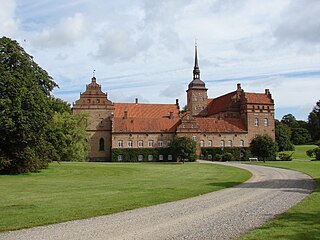
The Barony of Holckenhavn was a Danish majorat on the island of Funen, which existed from 1671 to 1921.
Otto Didrik Schack, Count of Schackenborg was a Danish aristocrat and officer. He was the fifth holder of the County of Schackenborg from 1796 to 1809 with the title of enfeoffed count.
















